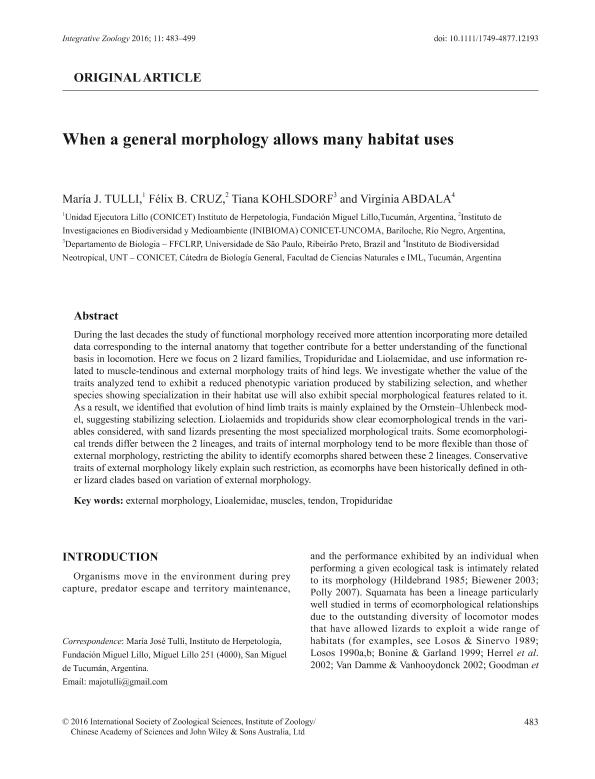Artículo
When a general morphology allows many habitat uses
Fecha de publicación:
11/2016
Editorial:
Wiley Blackwell Publishing, Inc
Revista:
Integrative Zoology
ISSN:
1749-4877
Idioma:
Inglés
Tipo de recurso:
Artículo publicado
Clasificación temática:
Resumen
During the last decades the study of functional morphology received more attention incorporating more detailed data corresponding to the internal anatomy that together contribute for a better understanding of the functional basis in locomotion. Here we focus on 2 lizard families, Tropiduridae and Liolaemidae, and use information related to muscle-tendinous and external morphology traits of hind legs. We investigate whether the value of the traits analyzed tend to exhibit a reduced phenotypic variation produced by stabilizing selection, and whether species showing specialization in their habitat use will also exhibit special morphological features related to it. As a result, we identified that evolution of hind limb traits is mainly explained by the Ornstein–Uhlenbeck model, suggesting stabilizing selection. Liolaemids and tropidurids show clear ecomorphological trends in the variables considered, with sand lizards presenting the most specialized morphological traits. Some ecomorphological trends differ between the 2 lineages, and traits of internal morphology tend to be more flexible than those of external morphology, restricting the ability to identify ecomorphs shared between these 2 lineages. Conservative traits of external morphology likely explain such restriction, as ecomorphs have been historically defined in other lizard clades based on variation of external morphology.
Palabras clave:
External Morphology
,
Lioalemidae
,
Muscles
,
Tendon
,
Tropiduridae
Archivos asociados
Licencia
Identificadores
Colecciones
Articulos(UEL)
Articulos de UNIDAD EJECUTORA LILLO
Articulos de UNIDAD EJECUTORA LILLO
Citación
Tulli, María José; Cruz, Felix Benjamin; Kohlsdorf, Tiana; Abdala, Virginia Sara Luz; When a general morphology allows many habitat uses; Wiley Blackwell Publishing, Inc; Integrative Zoology; 11; 6; 11-2016; 483-499
Compartir
Altmétricas




